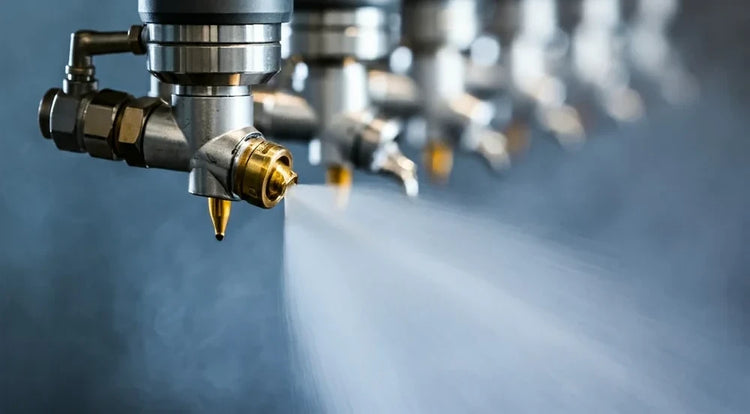Ultimate Spray Nozzle Glossary & Technical Guide
The most comprehensive spray nozzle terminology, specifications, and application reference available. Master every aspect of spray technology from basic concepts to advanced engineering specifications. Your complete resource for spray nozzle knowledge.
Spray Patterns Explained
Understanding spray patterns is fundamental to selecting the right nozzle for your application
Flow Characteristics & Specifications
Key parameters that define nozzle performance and compatibility with your systems
Nozzle Materials & Durability
Choose the right material for your operating environment and application demands
Brass
A durable, cost-effective choice for low-pressure applications. Offers good value, moderate wear resistance, and corrosion tolerance suitable for general-purpose industrial applications and temporary installations. Brass typically operates best at pressures below 100 PSI. Excellent machinability allows for custom configurations. Common in agricultural spray systems and low-cost commercial applications.
Stainless Steel
Stronger and significantly more corrosion-resistant than brass. Ideal for high-pressure systems, outdoor exposure, corrosive environments, and demanding industrial applications requiring superior longevity and reliability. Maintains integrity in harsh weather, chemical exposure, and high-pressure operation. Premium choice for permanent installations, food processing, and applications involving saltwater or acidic chemicals. Excellent for pharmaceutical and cleanroom applications.
Acetal (Delrin)
Lightweight, thermoplastic polymer with excellent chemical resistance. Perfect for low-pressure, non-corrosive applications. Ideal where weight reduction is important and aggressive chemical contact is expected. Resistant to most organic solvents and provides good dimensional stability. Common in laboratory applications, irrigation systems, and portable equipment. Temperature range typically -20°C to +70°C.
Polypropylene (PP)
Affordable, chemically resistant plastic material suitable for moderate-pressure applications. Resistant to corrosion and many chemicals. Cost-effective choice for temporary or portable spray systems in controlled environments. Lightweight and excellent for chemical compatibility with acids, bases, and solvents. Limited to pressures below 60 PSI and temperatures below 60°C. Common in agricultural and general industrial applications.
Polytetrafluoroethylene (PTFE)
Highly resistant to abrasion, chemicals, and extreme temperatures. Superior non-stick properties and durability in harsh environments. Ideal for pharmaceutical, food processing, and chemical handling applications. Maintains performance across extreme temperature ranges and with aggressive chemical exposure. Non-reactive with virtually all chemicals. Premium material for mission-critical applications requiring maximum durability and compatibility.
Tungsten Carbide
Extremely hard, highly wear-resistant composite material. Perfect for abrasive applications, high-velocity impacts, and applications involving particulate materials. Maximum durability for the most demanding conditions. Used in sandblasting, slurry applications, and abrasive slurry pumping. Up to 10 times more durable than brass in wear applications. Premium choice for applications requiring maximum longevity despite abrasive conditions.
Viton Seals
Synthetic elastomer offering exceptional resistance to heat, chemicals, oils, and solvents. Used in sealing components throughout nozzle assemblies. Maintains performance in extreme temperature ranges, -20°C to +200°C, ensuring reliable long-term operation. Essential for applications involving petroleum products, high-temperature fluids, and aggressive chemical environments. Ensures leak-free operation across temperature extremes.
Ceramic
Advanced material option for extreme wear resistance and chemical inertness. Extremely hard surface suitable for highly abrasive applications. Excellent thermal stability and resistance to erosion. Used in high-performance industrial applications where maximum durability is required. Superior performance in slurry and sand applications compared to tungsten carbide in certain conditions.
Nozzle Components & Construction
Understanding nozzle parts helps optimize selection and maintenance
| Component | Function & Description | Key Considerations | Maintenance |
|---|---|---|---|
| Cap | Protective cover for the orifice preventing damage during storage, transport, and handling. Prevents accidental spraying and protects precision opening from contamination. | Protects orifice from damage, dust, and contamination. Essential for equipment longevity and safety. Many nozzles include tethered caps for field use. | Inspect regularly for cracks. Replace if damaged. Keep cap on when nozzle is not in active use. |
| Orifice | The critical opening through which liquid flows, directly determining flow rate and spray pattern formation. The precision-drilled or molded opening that shapes the spray characteristics. Most critical component for performance. | Critical precision component. Size affects performance significantly. Even microscopic variations affect flow rate and pattern. Blockages cause performance degradation requiring cleaning. | Regular cleaning prevents buildup. Use ultrasonic cleaning for stubborn deposits. Replace if erosion or wear is detected. Keep clean with appropriate water filtration. |
| Shroud | External component that shapes the spray pattern and guides liquid distribution. Controls spray angle, pattern geometry, and coverage characteristics. Works in conjunction with internal vanes to create desired spray geometry. | Design influences coverage angle, drift characteristics, and application efficiency. Different shroud designs create dramatically different spray patterns. Critical for obtaining specified spray angle. | Inspect for cracks or damage. Clean exterior regularly. Shroud damage affects spray pattern unpredictably. Replace if any deformation is noted. |
| Stem | The connection point that attaches the nozzle to the spray system manifold or boom. Provides structural support and the interface between nozzle and spray equipment. Thread type and size critical for compatibility. | Must provide secure, leak-free connection. Available in various thread types (NPT, BSPT, metric) and sizes. Mismatched stems cause leaks and nozzle rejection. | Check threads for damage. Use thread sealant tape on male threads. Inspect for corrosion. Tighten periodically as vibration can loosen connections. |
| Vanes | Internal flow-guiding components that control spray direction, rotation, and distribution patterns. Located inside the nozzle body, they guide liquid through precise paths to create the desired spray pattern. Critical for spray uniformity. | Design determines spray uniformity and pattern characteristics. Affects droplet size and coverage consistency. Vane configuration varies by spray pattern type. Blockages disrupt flow. | Clean carefully to avoid damaging vanes. Ultrasonic cleaning effective. Replace if vanes are cracked or eroded. Blockages here severely degrade performance. |
| Nozzle Body | The main housing containing all components. Manufactured from selected material based on application requirements. Houses the internal passages and vanes that create specific spray patterns. | Material selection critical for durability and chemical compatibility. Body must withstand operating pressure without deformation. Structural integrity essential for performance. | Inspect for cracks, corrosion, or erosion. Check for any weeping or leaks around seams. Replace if structural integrity is compromised. Clean exterior regularly. |
Common Spray Applications
Nozzles are engineered for specific tasks and industries
Industries & Specialized Applications
Industry-specific requirements and nozzle solutions
Food & Beverage Processing
Requires stainless steel or PTFE nozzles for sanitary applications. Must comply with food safety regulations. Used for cleaning, cooling, humidification, and product processing. Chemical-resistant materials essential for sanitizer compatibility.
Agriculture & Crop Spraying
Requires precise spray patterns for herbicide and pesticide application. Calibration critical for consistent application rates. Brass or stainless steel construction for durability. Flow rate must match ground speed for accuracy.
Manufacturing & Industrial
High-pressure systems for cleaning, cooling, and process applications. Often requires customized solutions for unique production requirements. Durability and reliability critical for 24/7 operation.
Automotive & Vehicle Washing
Balanced pressure washing for paint safety and efficiency. Requires adjustable pressure ranges for different cleaning tasks. Quick-disconnect couplings for equipment portability.
Chemical Processing
Chemical-resistant materials critical for compatibility. May require exotic materials or coatings. Precise flow control essential for process accuracy and safety.
Pharmaceutical & Healthcare
Sterilizable materials required. Often stainless steel or specialized polymers. Sterility critical for medical applications. Full traceability and documentation often required.
Water Treatment & Environmental
Chemical and UV resistant materials for outdoor exposure. Must handle variable water quality and chemistry. Large-scale spray patterns for area coverage efficiency.
HVAC & Climate Control
Humidification nozzles for air handling systems. Precision droplet size for complete evaporation. Ensures optimal humidity without surface wetting or water damage.
How to Select the Right Nozzle
A systematic approach to finding your optimal spray solution
1. Define Your Application
Identify the specific task: cleaning, coating, cooling, humidification, dust suppression, or other specialized function. Understanding your primary objective narrows down spray pattern requirements and performance parameters needed. Consider whether you need uniform coverage, high impact, or fine mist.
2. Determine Flow Requirements
Calculate required flow rate (GPM or LPM) based on coverage area and application speed. Match system pump capacity. Consider pressure available and pressure drop across nozzle to ensure optimal performance. A simple calculation: Coverage Area (sq ft) × Application Rate (GPM/sq ft) = Required Flow Rate.
3. Select Spray Pattern
Choose pattern type based on coverage needs: full cone, hollow cone, flat fan, air atomizing, or jetting. Consider target area geometry, desired uniformity, drift sensitivity, and penetration requirements for optimal results. Each pattern offers distinct advantages for different applications.
4. Evaluate Materials
Consider operating environment: temperature, pressure, chemical compatibility, and durability needs. Select material offering best balance of cost, performance, and longevity for your specific conditions. Premium materials justify cost in harsh or permanent installations.
5. Verify Compatibility
Ensure stem type and thread size match your existing spray boom or manifold. Check pressure ratings and flow capacity compatibility with pump specifications. Verify all connections are secure and leak-free. Mismatched connections cause system failures.
6. Test and Optimize
Conduct field trials to verify performance meets expectations. Monitor spray pattern uniformity, coverage, and efficiency. Make adjustments to pressure or nozzle selection based on real-world results. Often requires fine-tuning for optimal results.

